It’s that time of the year – Notre Dame is gearing up for its annual game against Navy. This year it’s a service academy doubleheader with the Shamrock Series game against Army next week. And with service academies comes everyone’s favorite yearly annoyance – the triple option.
So today we’re stepping into the 18 Stripes Film Room for a breakdown of Navy’s option offense. Army’s offense is very similar to Navy’s, but they do things a little differently so we’ll take a quick look at them next week as well.
What is the triple option?
If you want to get technical, the triple option is just one type of play, not an entire offense. But the triple option is the base play of Navy’s offense and they run it quite a bit, so the name of that one play has morphed into a way of describing the whole offense.
The goal of the triple option – or any option play – is to read a defender instead of blocking him. If he reacts one way, the quarterback does something that makes that player “wrong.” In essence, that player is “blocked” without needing a physical blocker. This is no different than the standard zone read (or also called the read option) that is everywhere in college football today, even at Notre Dame.
But before we get too far into the weeds, let’s talk about formations first.
Formations
This is the base formation of Navy’s offense, known technically as “spread” but more colloquially called the flexbone.
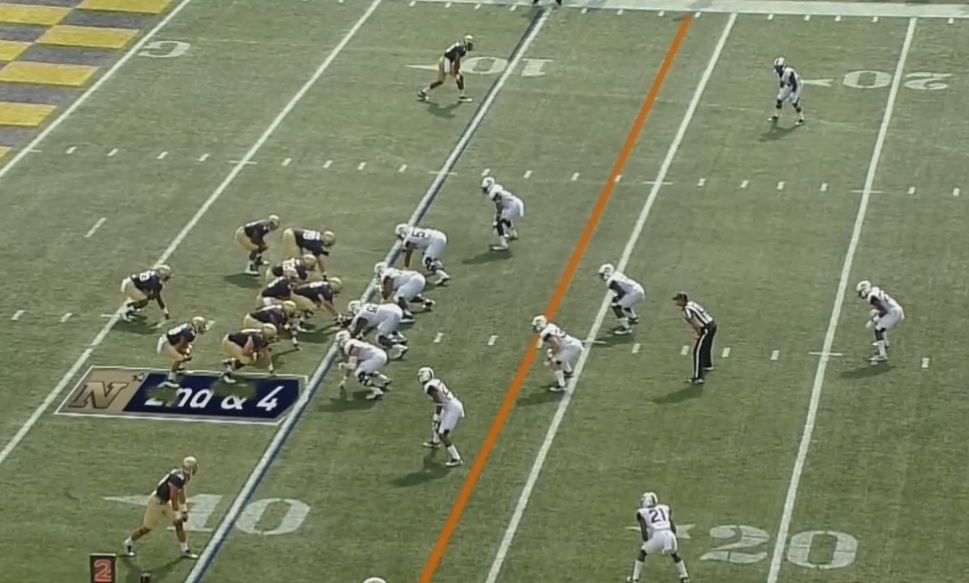
This formation is similar to the old wishbone formation but with the two running backs flexed out to the slot – thus, flexbone. It’s a balanced formation so plays can be run to either side.
Navy also likes to bring the wide receivers in tight to the line.
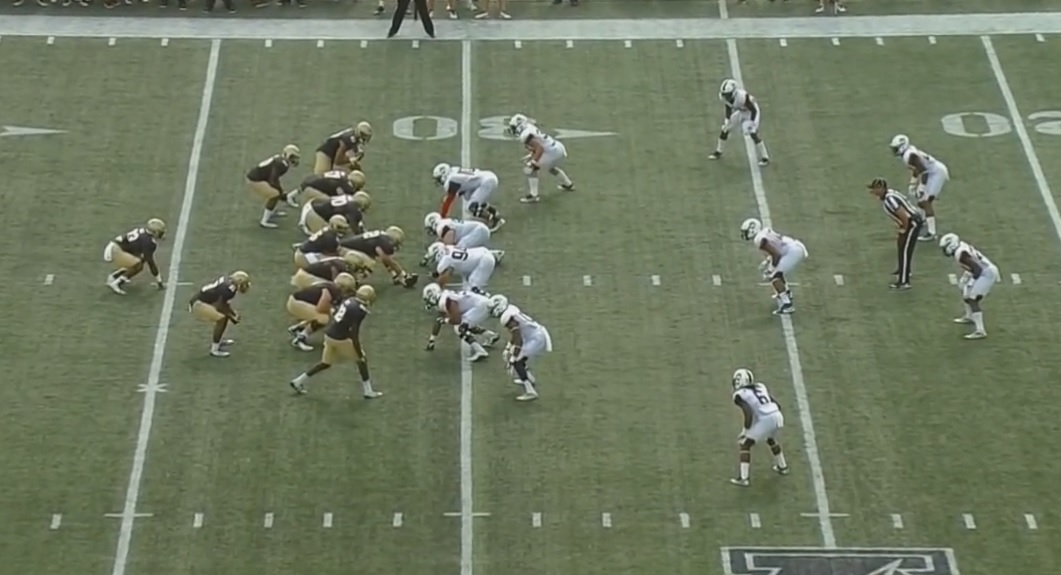
Here, the wide receivers can be used more effectively as blockers, especially on linebackers.
You’ll also occasionally see both receivers lined up on the same side.
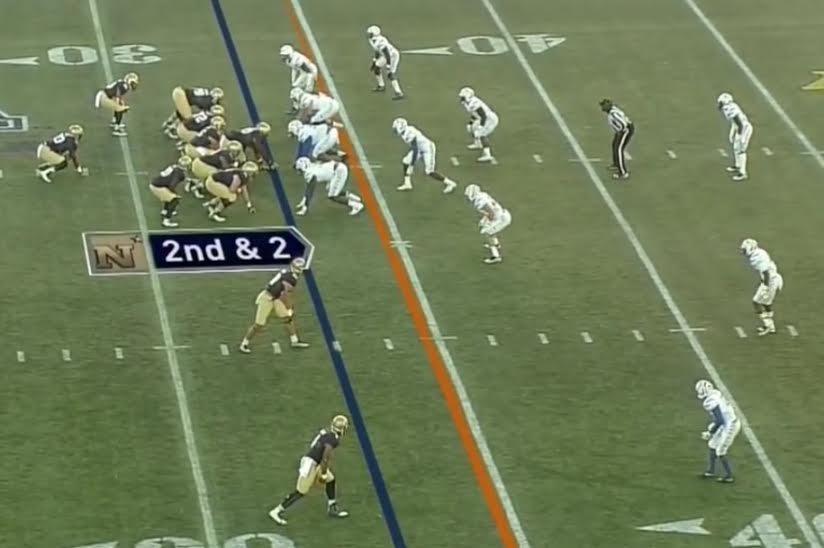
The inside receiver is ineligible but the defense can’t completely ignore him. He can still block downfield on running plays so the defense still has to account for him or risk getting out-leveraged.
Finally, Navy will also move a slotback over to the other side of the field as a slot receiver.
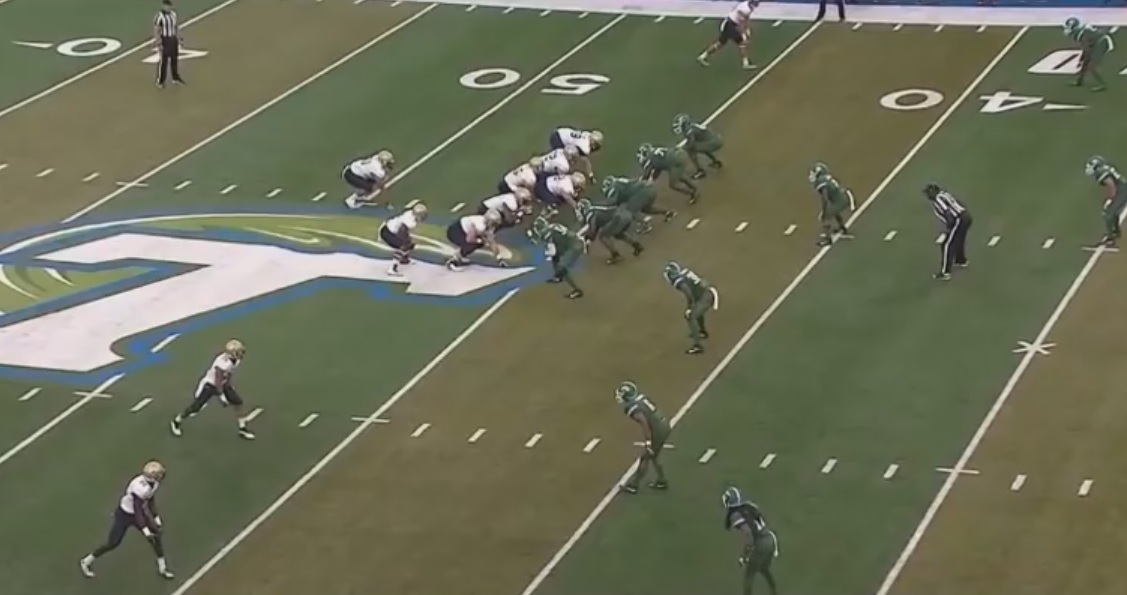
This looks a lot like a standard “trips” set in a spread offense. This is generally used in passing situations, but it has its uses in the run game.
This is not an exhaustive list and Navy likes to mix things up with their formations. But most of what you’ll see on Saturday will probably look similar to one of these four formations.
The Triple Option
Ok, now let’s get to the good stuff.
As the name implies, there are three options to this play. The quarterback can hand the ball off to the fullback on the dive, he can keep the ball and run it himself, or he can pitch the ball to the slotback.
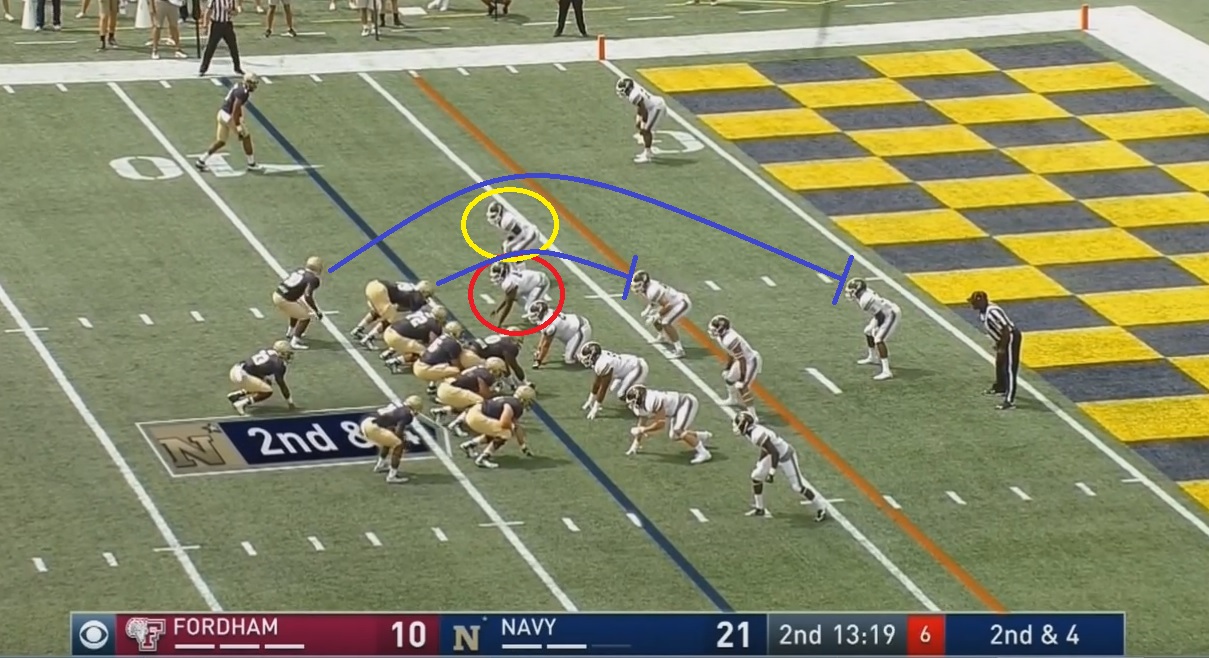
The quarterback reads the defensive end (red circle) on the dive and the outside linebacker (yellow circle) on the pitch. Since those two players are optioned off, they don’t need to be blocked. Instead of blocking the defensive end and outside linebacker, the offensive tackle generally blocks a linebacker and the slotback blocks a safety (blue lines).
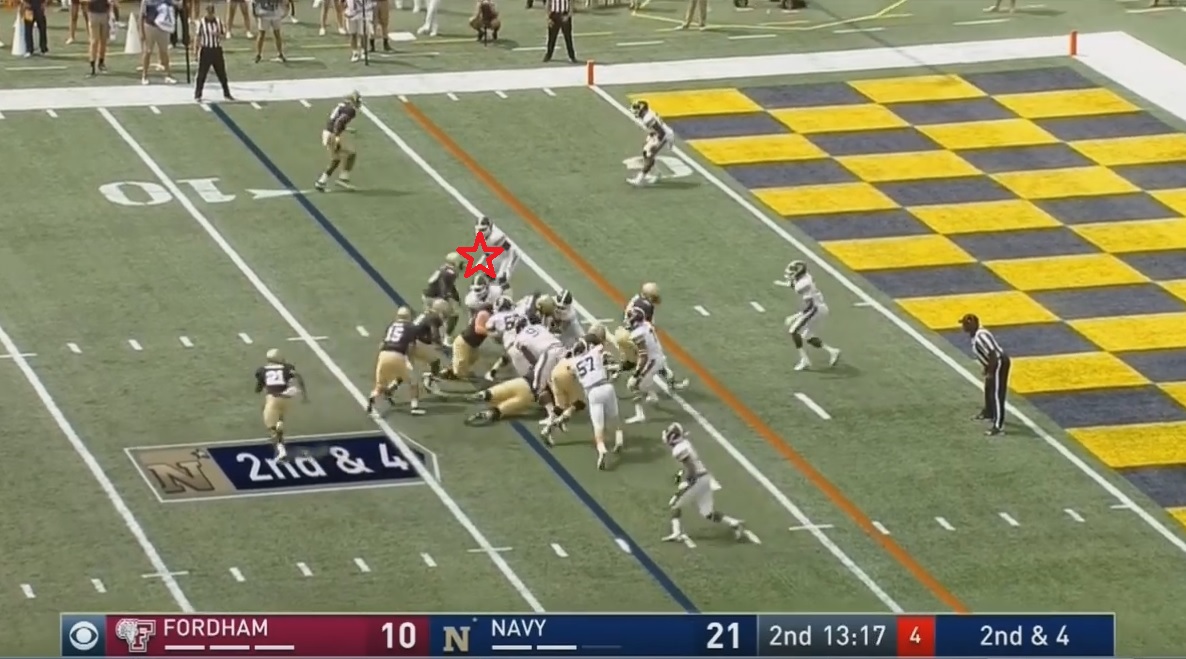
Right before the snap, the slotback to the opposite side of the play starts in motion. He will be the pitch player.
At this point, you can see the defensive end (red star) has turned his shoulders and making a play on the fullback to stop the dive.
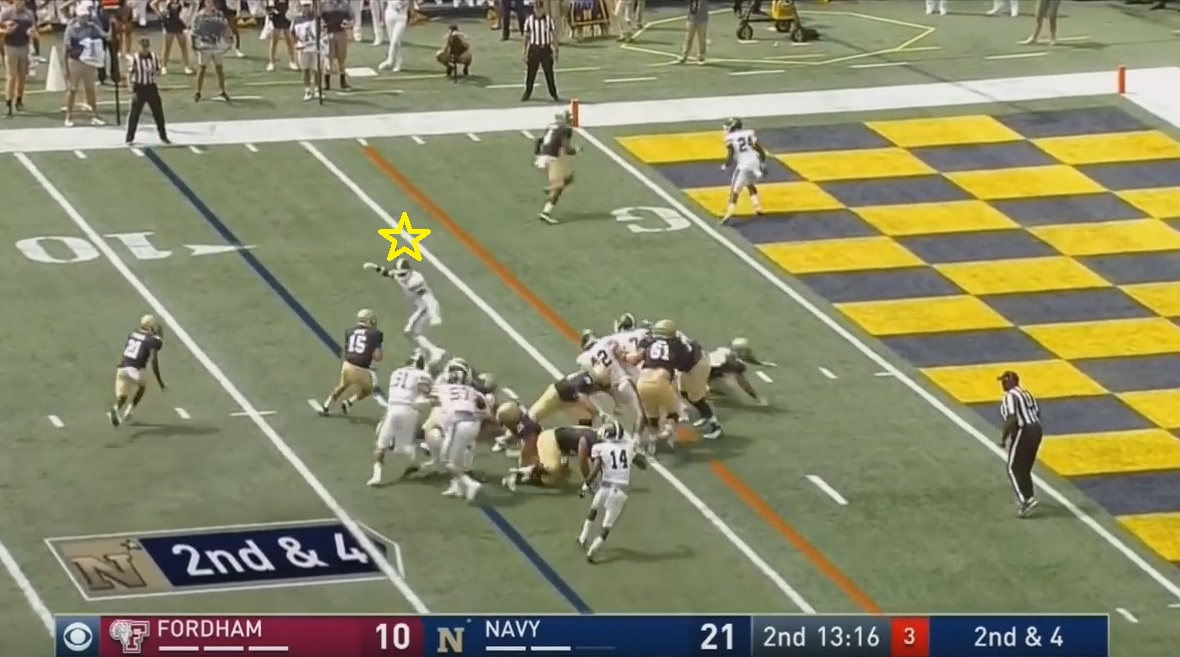
With the dive covered, the quarterback pulls the ball. Next, he reads the outside linebacker (yellow star). Here, the linebacker is shuffling outside to cover the pitch, so the quarterback keeps the ball.
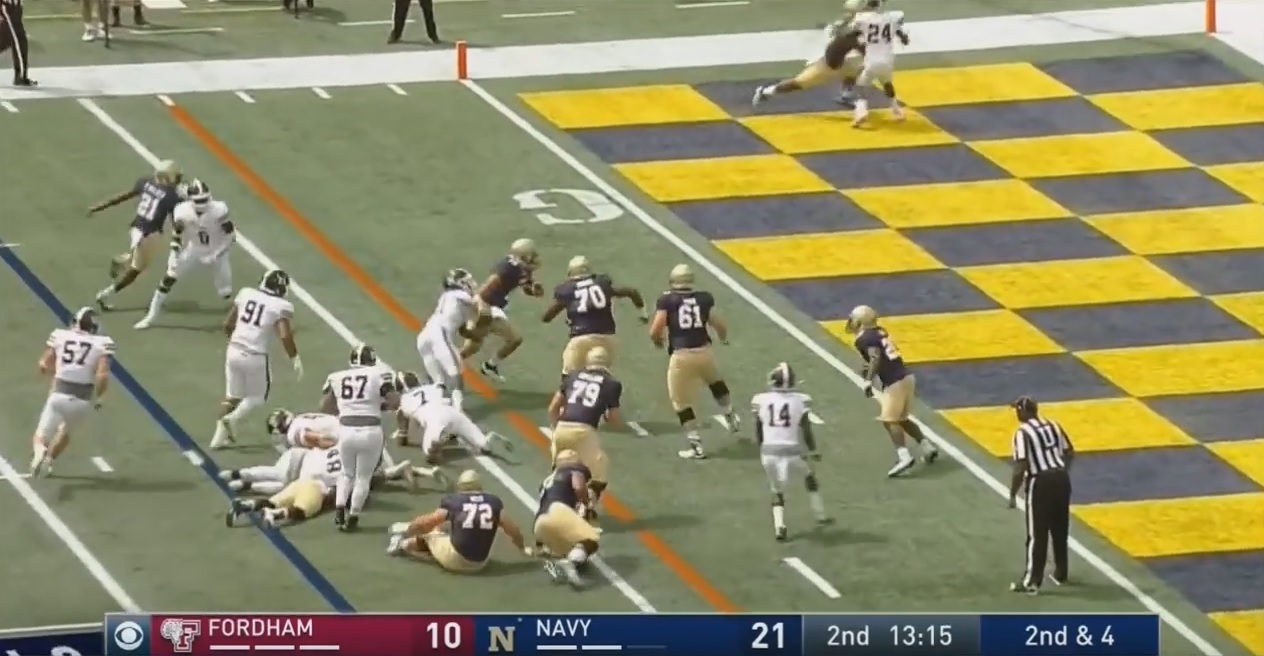
The quarterback makes it almost four yards without being touched by a defender.
Expect to see this a lot on Saturday. Navy is content to run this play over and over again, and a lot of their offense is built on taking advantage of the defense’s reaction to this one play.
The Dive
This play is exactly what the name implies – it’s a straight dive play to the fullback. It’s really not much different than a standard inside zone run you’ve probably seen Notre Dame run a million times – everyone blocks the guy in front of him and the fullback runs through the hole.
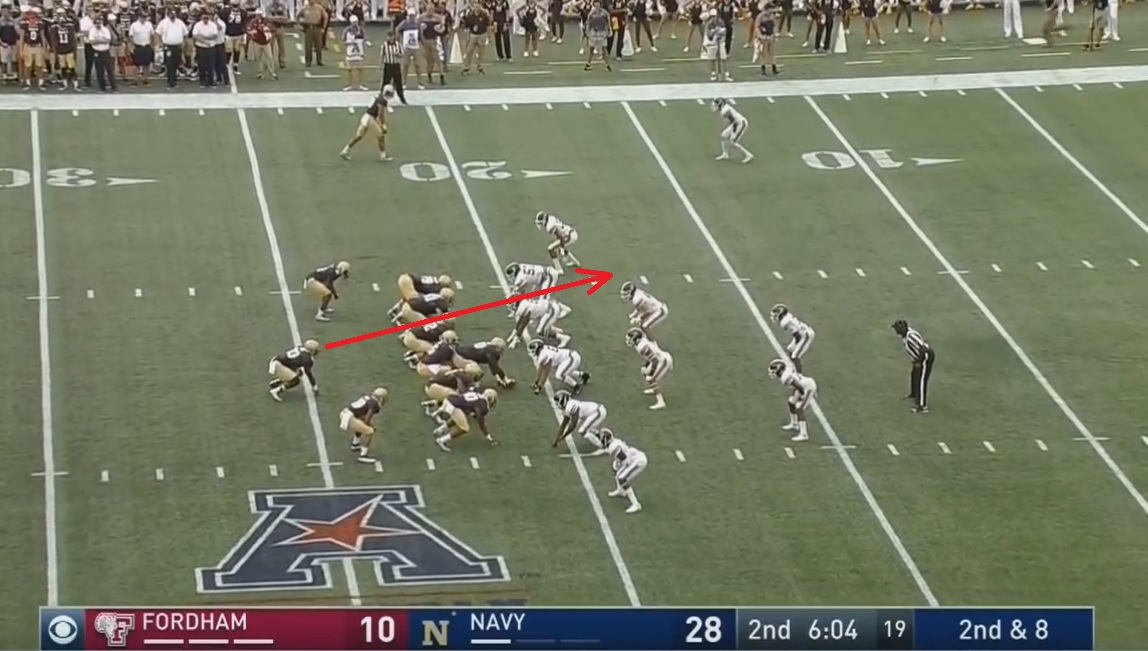
In the picture above, Navy is in a “heavy” formation, meaning they moved the right tackle over to the left side and lined up a wide receiver next to the guard on the right side. For the purposes of this explanation, though, the formation isn’t important.
The fullback is going to take the handoff and run straight ahead.
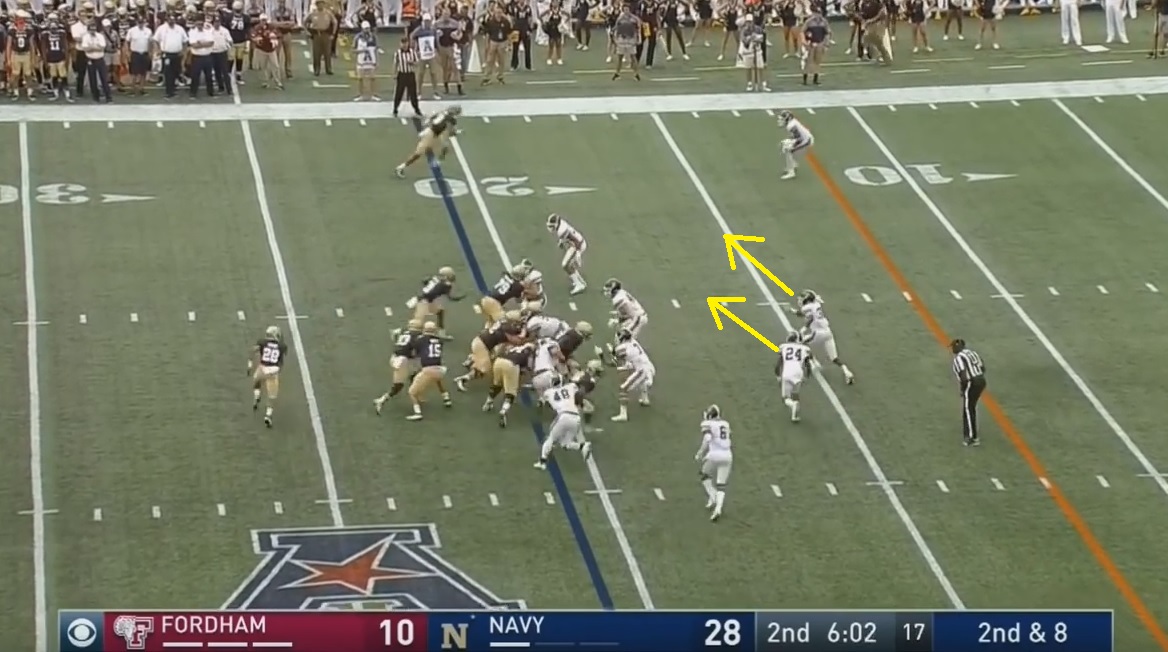
What makes this play effective is the fact that it looks exactly like a triple option. The linebackers or safeties might read it as a triple option and flow outside to take the quarterback or pitch. You can see on this play the two safeties turned immediately towards the sideline.
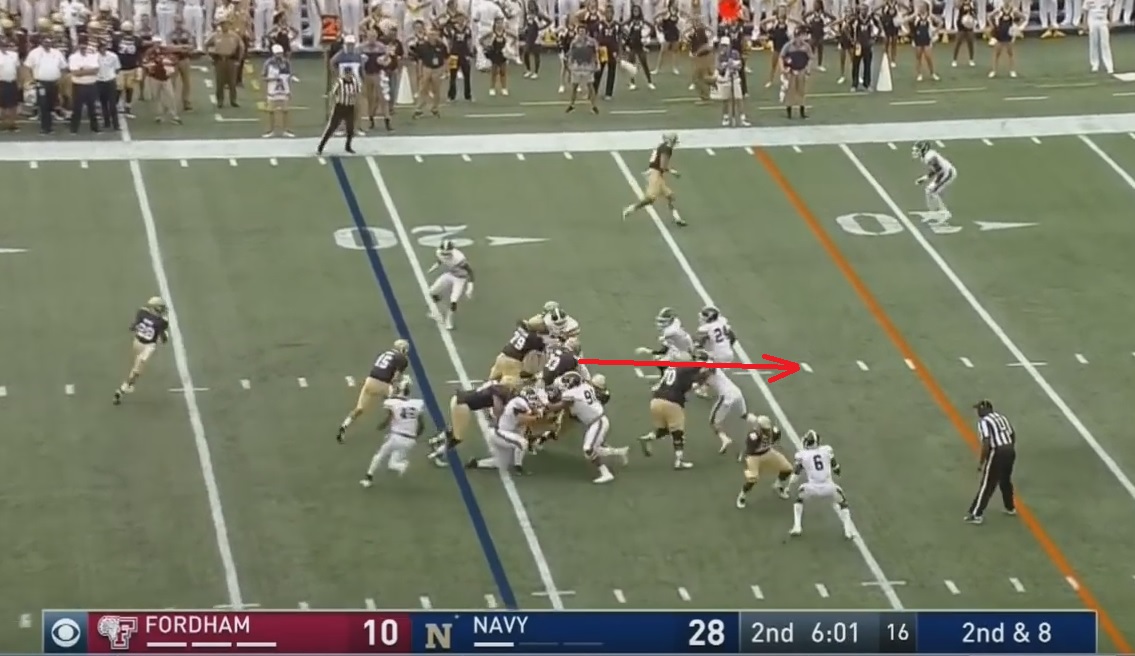
Sure enough, both safeties overran the play and the fullback runs right by him. This is how Navy can gash undisciplined defenses with the fullback even when the defensive end is “assigned” to stop the dive.
How can you tell a triple option from a dive? Watch the offensive tackle. If he blocks the defensive end, it’s a dive. If he moves up to block a linebacker, it’s an option.
The Speed Option
Next up is the speed option (shoutouts to downinthebend). This is a double option, where the quarterback can only keep the ball or pitch it. There is no dive option.
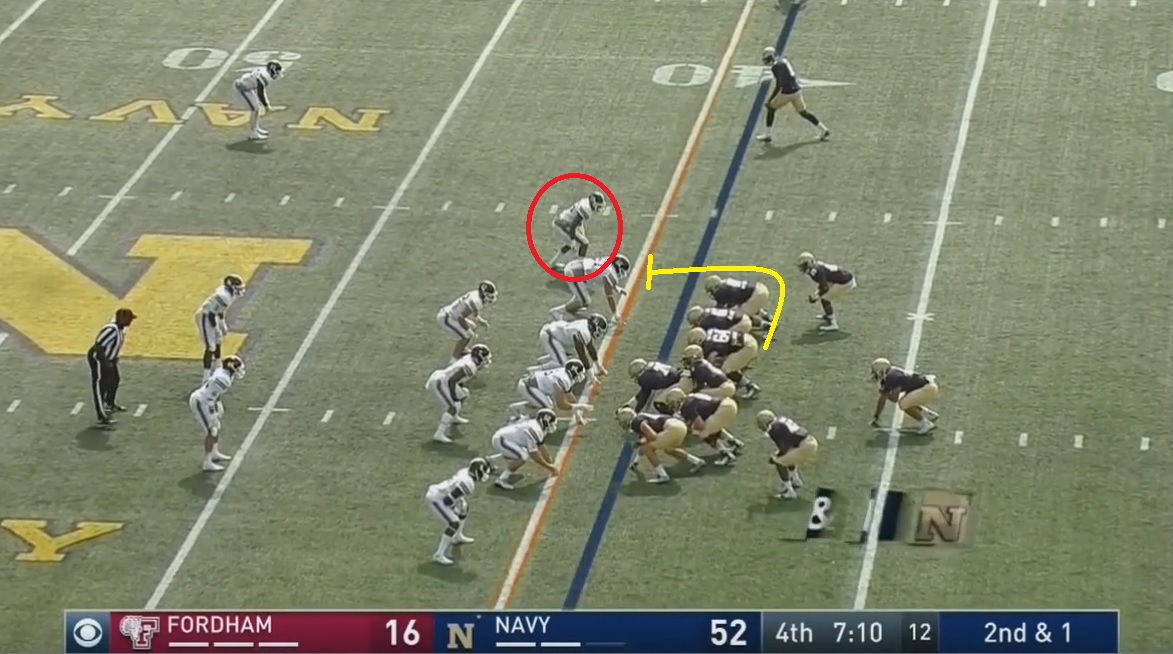
Again, Navy is in a heavy formation, but that doesn’t really change the mechanics of the play.
Since this is a double option, only one player is left unblocked. On this play, the offensive guard throws a trap block on the defensive end. The two offensive tackles double team the defensive tackle, while the guard pulls around (yellow line) to cut the defensive end. The defensive end is initially left unblocked, so he probably reads this play as a triple option and goes inside to stop the dive. This helps draw the end inside so he’s easier to block and gets him out of the quarterback’s way.
The optioned defender is the outside linebacker (red circle). Of course, there are variations of this play where the defensive end is optioned and the linebacker is blocked.
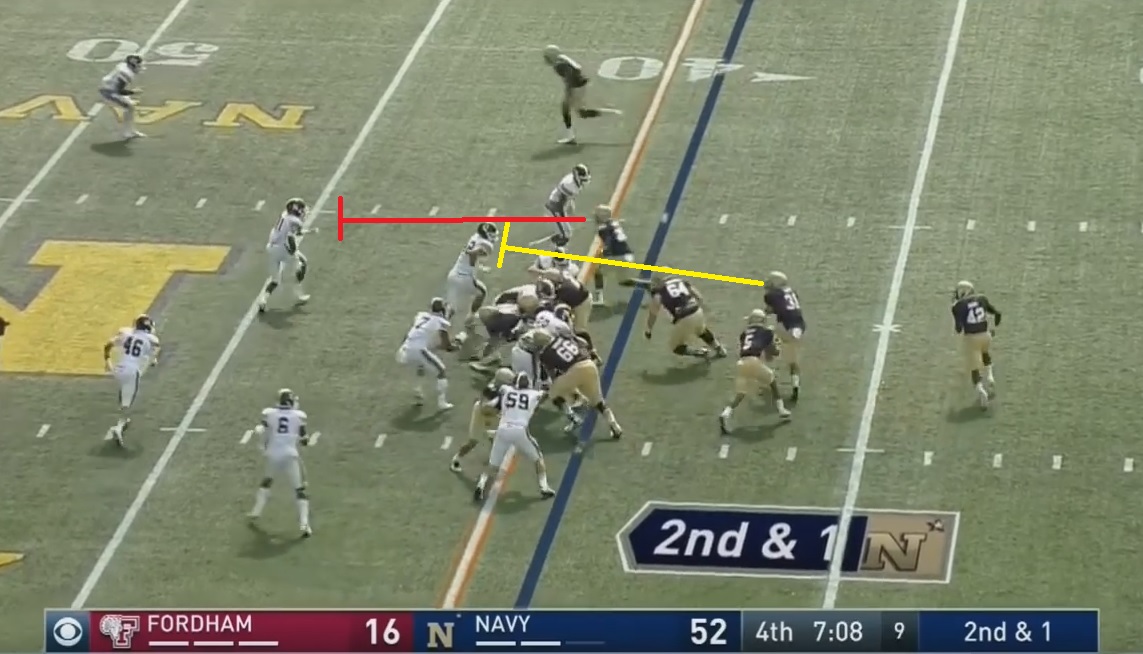
The defensive end crashes down expecting a dive but the guard is already sizing him up for a cut block. The fullback is leading the way to block the linebacker scrapping outside (yellow line), and the slotback will take the safety (red line).
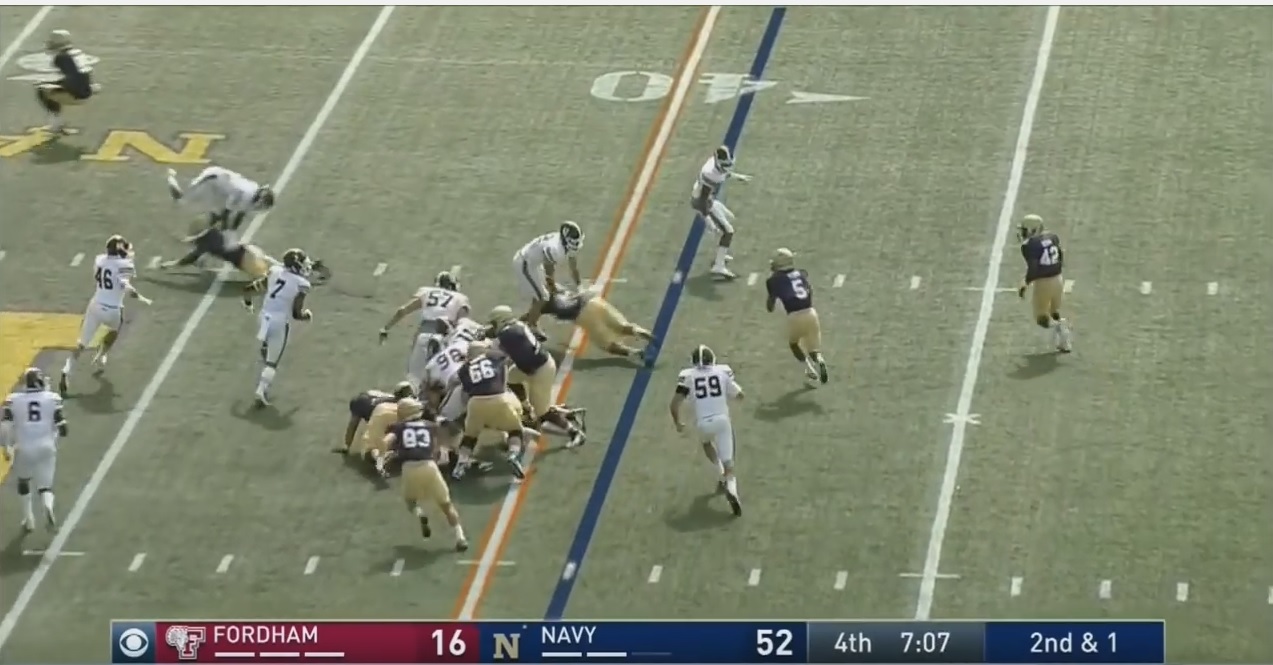
The outside linebacker defends the pitch and the quarterback has a lot of room to run.
The Midline
The midline is basically the opposite of the speed option. Whereas the speed option has only keep and pitch options, the midline has only dive and keep options. What’s unique about the midline is that the defensive tackle is optioned, not the defensive end.
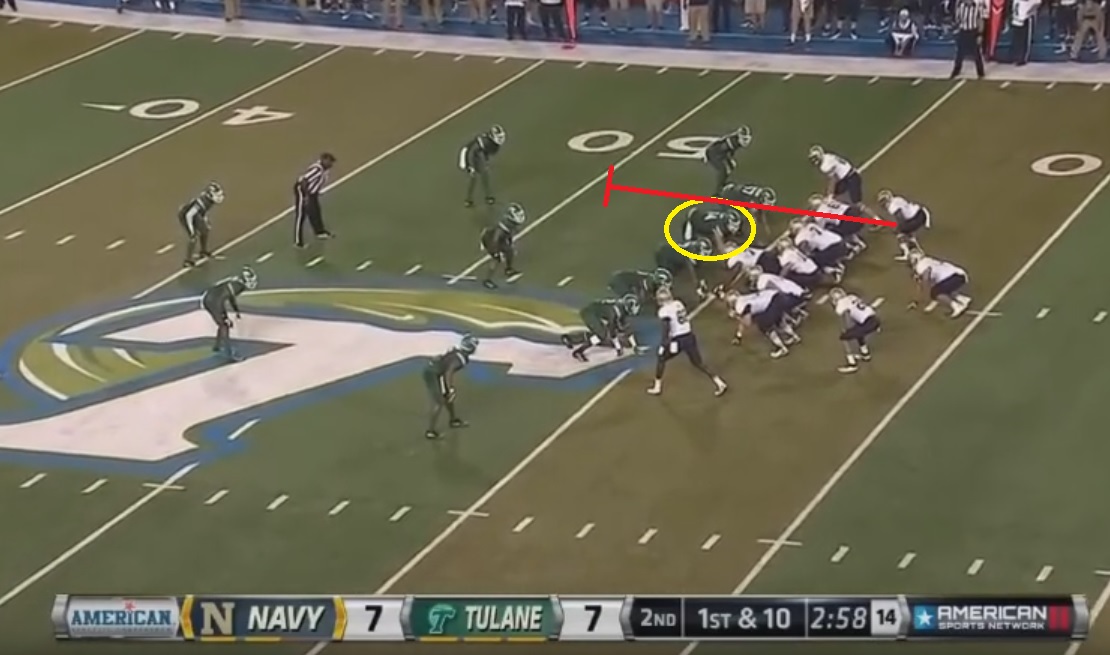
The defensive tackle (yellow circle) is the optioned player. The slotback will still go into motion like it’s a triple option play, but he’s only a decoy. The playside slotback (red line) will act as a lead blocker for the quarterback instead of going outside to block a defensive back.
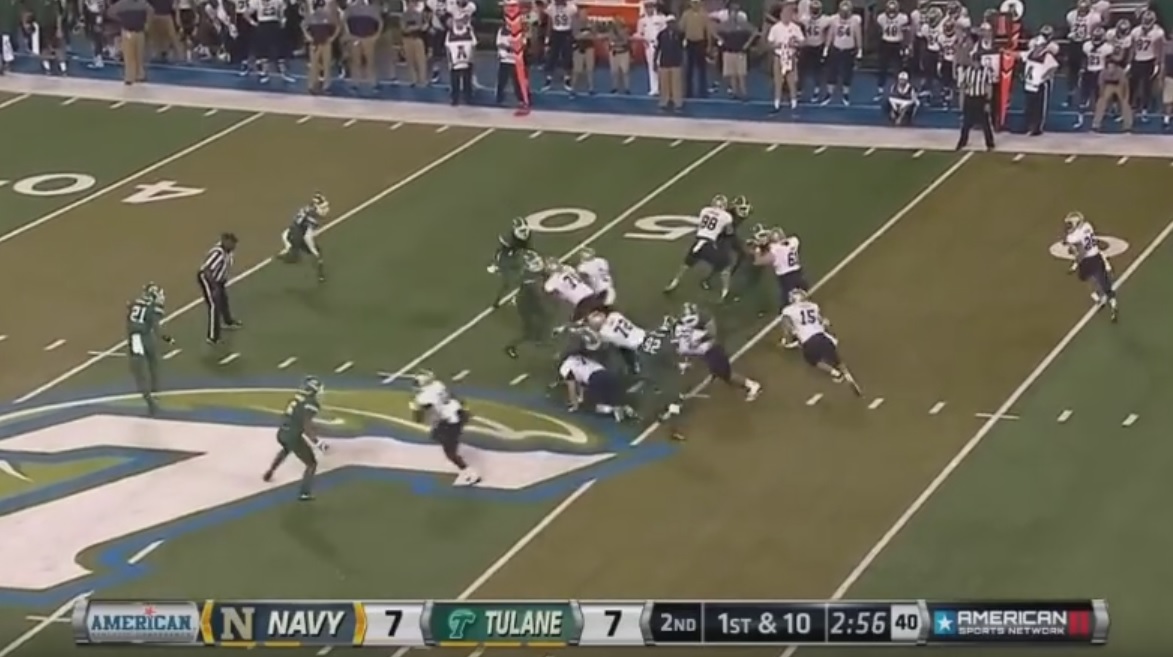
The defensive tackle takes the fullback so the quarterback keeps the ball. The offensive tackle and wide receiver make nice kick out blocks and open a hole for the quarterback with the slotback leading the way.
The midline is a good short yardage play but can also be used to punish defenses for abandoning the middle of the field to defend the edges.
The Midline Triple Option
One variation of the midline is the midline triple option. Think of it as a mashup of the normal triple option and the midline. Instead of optioning the defensive end on the dive and the outside linebacker on the pitch, the reads are moved inside one player.

The defensive tackle (yellow circle) is read on the dive and the defensive end (red circle) is read on the pitch.
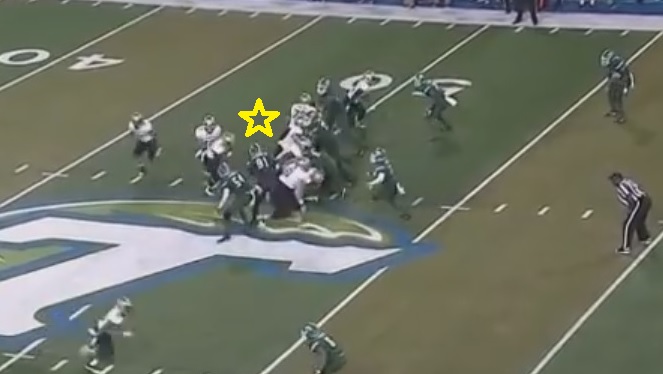
The defensive tackle (yellow star) crashes on the fullback, so the quarterback keeps the ball. Meanwhile, the offensive guard is free to double team the nose tackle with the center to wall him off from the play. The offensive tackle can move up to block a linebacker.
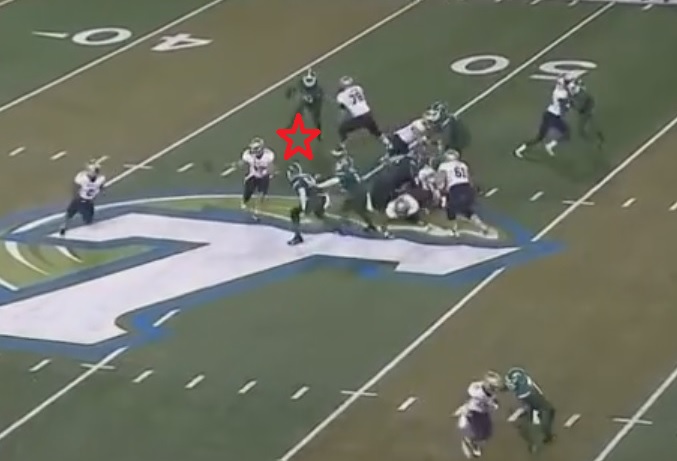
The defensive end (red star) takes the quarterback, so he pitches to the trailing slotback. Navy lined up with the playside slotback lined up as a slot receiver, pulling a defender outside with him. This created a lot of room on the edge.
The midline triple option isn’t a very common play, but it’s useful when a team has a disruptive defensive line. Sometimes it’s easier to just option players off instead of blocking them.
The Passing Game
The passing game isn’t a huge part of Navy’s offense but I think it’s worth at least a few paragraphs of discussion.
As you might expect from a team that runs the ball as much as Navy, the passing game is pretty simplistic. There are a lot of rollouts, half-field reads, one read concepts, and plain old “max protect and chuck it up to the receiver running a fade route.” But I want to breakdown Navy’s most common pass concept, the switch.
The switch has its roots in the old run ‘n’ shoot offense. It’s a two route combination, sometimes simply called wheel/post to describe the two routes.
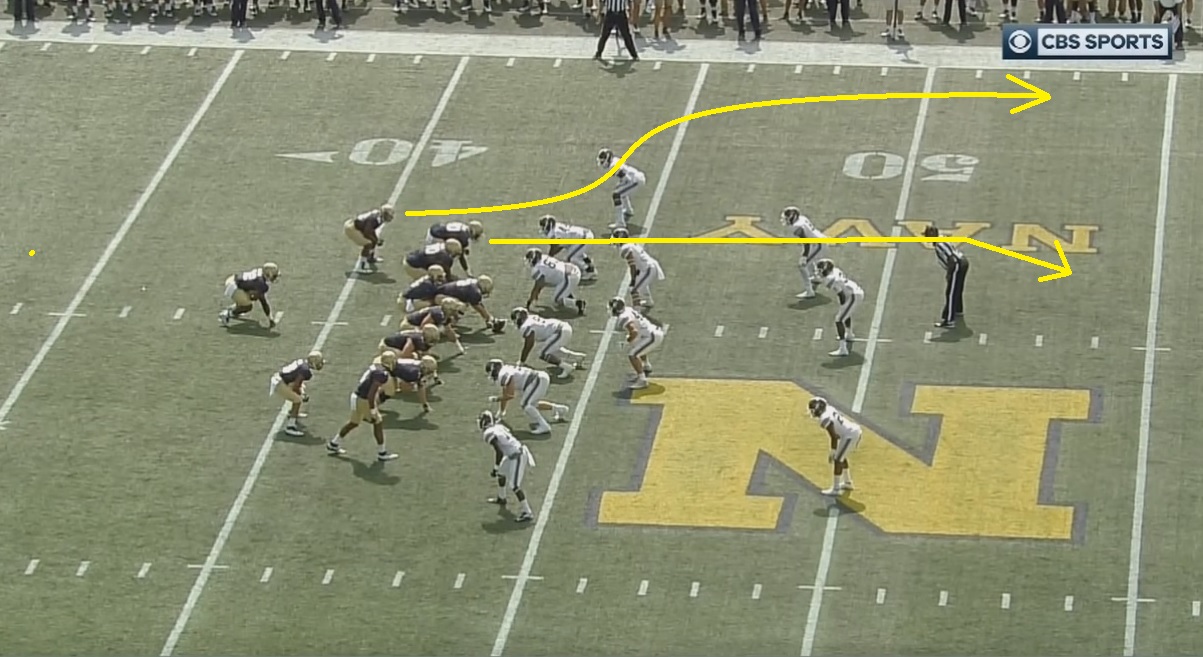
In more modern spread offenses, these routes are typically run by an outside receiver and a slot receiver. In Navy’s offense, it’s usually a slotback and a wide receiver. The wide receiver runs a post and the slotback follows him in a wheel route. In essence, the two players “switch” positions, thus the name. The idea is to get the two defenders to interfere with each other if they are in man coverage or for both defenders to cover the same guy in zone coverage.
In Navy’s offense, this is particularly effective. Usually slotbacks are covered by linebackers or safeties on pass plays. But the slotback’s wheel route looks like he’s going outside to block on an option play. The defender might read run and attack downhill. Meanwhile the slotback will run right by him wide open down the sideline. If the defense doesn’t fall for it, the wide receiver is still usually in one on one coverage so the quarterback still has the option to throw it to him on the post. The receiver might get a step on the corner or simply go up and catch a jump ball.
In the picture above, Navy is lined up in another heavy formation. The receiver will run the post from his “offensive tackle” position.
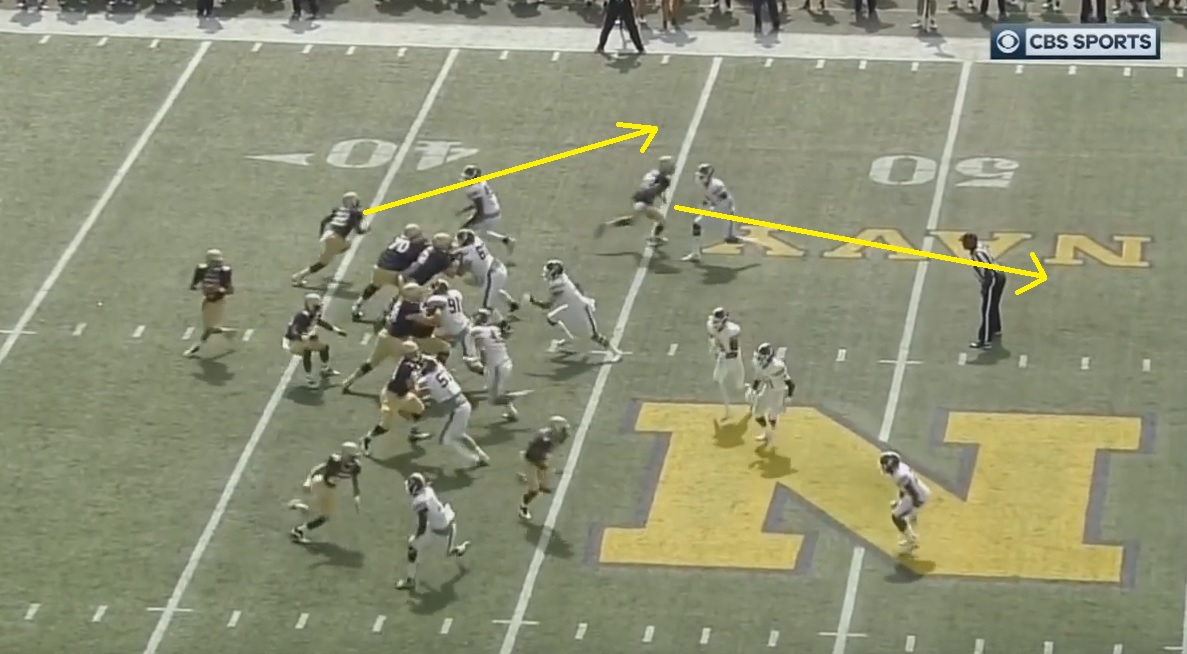
The outside linebacker sees the slotback release outside and reads run. He runs into the backfield while the slotback runs by him.
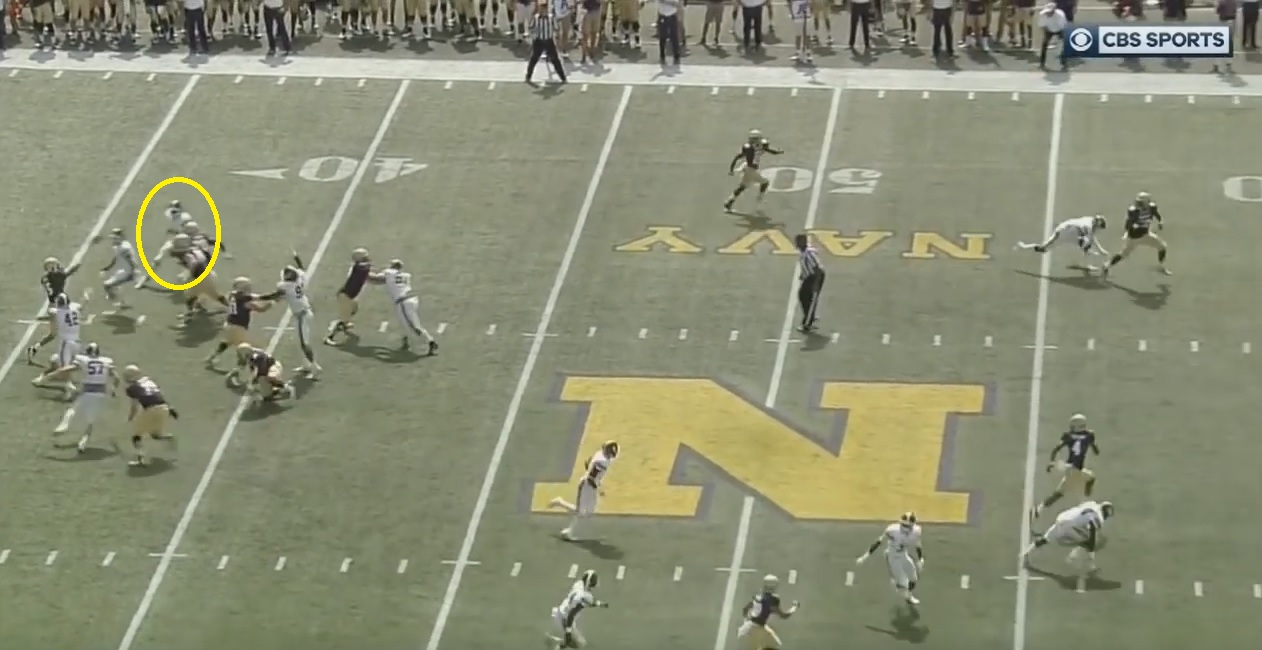
The linebacker (yellow circle) who should be covering the slotback is five yards into the backfield. The slotback has no one in his area code. Oops. Easy touchdown.
Wrapping Up
So that’s the basics of Navy’s option offense. We’ll be back in the film again next week with a review of Notre Dame’s defense versus Navy and then a quick look at Army.

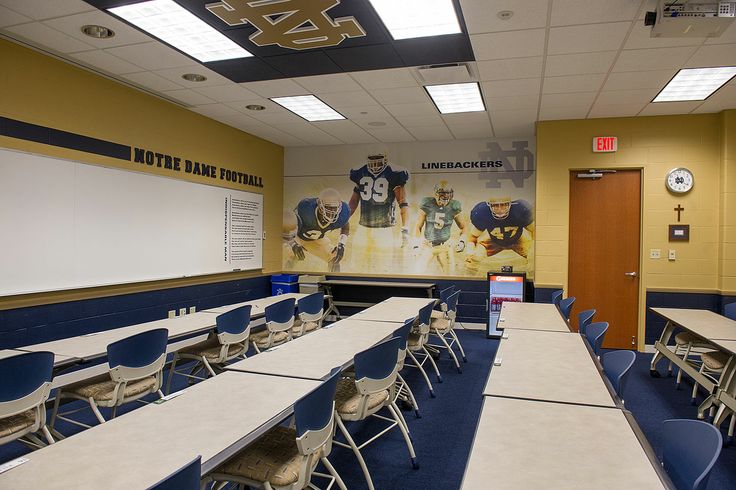

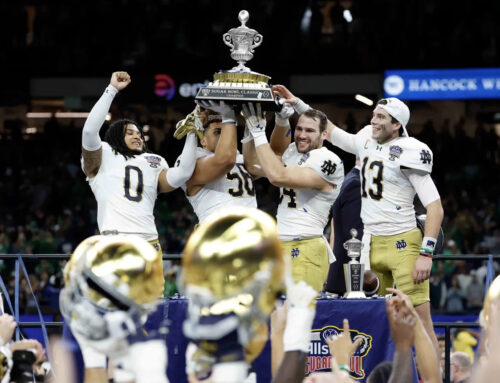
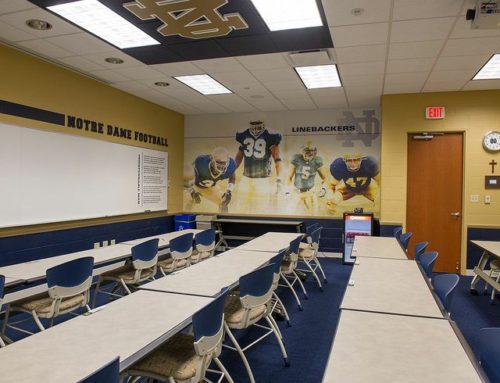
Love these previews and insights. Makes me glad I’m not the DC in charge of planning strategy to counter the options. What are the fundamentals of defending option offense? Thanks.
Same here. I didn’t appreciate the complexity of it all until I read burger’s stuff at our old home and my brain checked out halfway through the article. “We’re so much bigger/stronger/faster than them! How in the hell do we have any trouble defending them?” Well, this is how. Everything looks like everything else until the last second, and if you shift to stop one thing they shift accordingly. It’s intricate and complex, and it only looks so easy because they execute it to perfection.
For the defensive line, be disruptive. A tackle that can knife into backfield or a defensive end who can chase things down from the backside can cause a lot of problems. Watch the Clemson-Georgia Tech game for a good example. Obviously ND doesn’t have Clemson’s d-line, but even one negative play can derail a drive and force a punt.
For the linebackers and DBs, don’t get cut. It’s very hard to create a numbers advantage against the option without the risk of getting gashed by a counter. But if the safeties and linebackers can get off blocks then Navy will have a tough time moving the ball. Manti Te’o was the best I’ve seen at this and it’s no coincidence we destroyed Navy in 2011 and 2012. Keenan Reynolds not playing in those games also helped, but that’s a different discussion…
Great point on the “one play” thing – perhaps more than any other offense, the option is so heavily reliant on staying on schedule. They’re nearly guaranteed to pick up 3-4 yards every time, but getting more than that is very dicey. So even a single stuff can throw a wrench into things, especially if it leaves them in 3rd and long.
Also, one thing you absolutely DO NOT want to do against Navy is get caught switching out your torpedoes for bombs when their carrier planes suddenly appear from a direction you didn’t expect. I hope Hudson coaches the Zeros to expect the deep attack and be ready, even if we don’t think their carriers are anywhere near Midwa….
wait…maybe I need to put the WWII research to the side for a moment…
I dread it when ND plays option teams. I love it when they dominate the option, but I will always remember tearing my ND tag cover off of my truck after CW lost the first game to navy in like 1,000 years. That game still pisses me off.
Burger, in your opinion, if Navy consistently gives opponents fits with this scheme (even though their size / athleticism is low), why doesn’t Georgia Tech have a lot more success with the triple option, seeing as they have much bigger and athletic players?
A couple things…
1. The level of competition probably plays a factor. Navy only plays a handful of P5 teams a year, and since they’ve joined the AAC it’s only Notre Dame every year. Meanwhile, Tech has to play Georgia/Clemson/Miami/VT every year. That’s a whole different brand of athlete as opposed to the Tulanes and East Carolinas of the world.
2. Georgia Tech has had success under Johnson – offensively anyway. They’ve led the ACC in rushing every year under Johnson (they’re second this year behind Louisville because – Lamar Jackson). Their defense has been mediocre to bad which is probably the reason they don’t win more games. Their offense in 2014 was incredible – I think they were near the top in the country in S&P+.
They got killed with injuries last year and this year they have offensive line issues because of attrition and some poor recruiting coming to roost. But they still led the ACC in rushing last year and I think they’re still a top 40 offense this year according to S&P+ despite playing a ton of good defenses early in the year (BC, Clemson, Vandy, and Miami in the first 5 games).
Ok, I looked up Tech’s S&P+ offensive rankings under Johnson:
2008 – 38th
2009 – 21st
2010 – 61st
2011 – 15th
2012 – 13th
2013 – 21st
2014 – 3rd
2015 – 63rd
2016 – 46th
So they had a pretty nice run from 2011 to 2014.
It wouldn’t surprise me if crept into the mid-30’s by the end of the year. They finish the season with UNC/VT/UVA/UGA – not a ton of scary defenses.
Great preview, burger. What I find to be so wild (And impressive) is how seemingly seamless it all is. Starting QB goes down in Week 1? No problem, the backup offers little to no drop-off and the system remains the system.
(Speaking of, have to feel so bad for Tago Smith, sits for years behind the best QB at Navy since Staubach in Keenan Reynolds, finally gets his chance as a senior and then rips up his knee in the first half of Week 1. Such a shame for all his time and effort that getting to be a college QB wasn’t in the cards for him…I saw recently that the Naval Academy denied him a medical redshirt and won’t be allowing him back for another year, which seems to truly be unfair. Such is life, I suppose.)
Anyways, loved learning about the option and it’s going to be a bear to get through, as it has been in recent years. If ND is fortunate to get another early lead this week, any sort of turnover or special teams disaster could really be a game-changer. For once it would be nice to see a complete team effort and limited self-inflicted mistakes.
Navy lucked out with Worth. Having your senior starting QB get hurt is bad, but to be able to throw in another senior in his place is a luxury. Obviously there’s a reason Smith was the starter ahead of Worth, but it’s a lot easier to replace a senior with another senior instead of throwing an underclassman to the wolves.